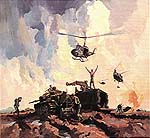Welding of Armour Steel in the Field

RAEME Knowhow asked Neil McMahon, Welding Instructor, at Gordon TAFE,
"What was the best electrical welding rod to use
to fill weld RPG penetrating holes in Centurion Tanks?"
Notes on Author .. Neil McMahon
In 1958 I did National Service in the Army and in then joined the C.M.F.
I was transferred to an armoured unit for the next three years, where I developed an appreciation of how much work was involved to keep the Centurions in the field.
I spent a day or two driving a ferret for the CO of 1 Armd Regt Colonel Coleman. I traveled with the tank crews on the engine hatches practicing for exercise "Firepower."
I can appreciate the dilemma of having a hole through the turret, not a confidence-building situation; also the possibility of one vehicle being out of action for some time, while a replacement was found.
To weld at the time, unknown steel, including armour steel, definitely the best electrode to use would be an austenitic stainless steel rod. This was my experience as an apprentice in the chemical industry back in the fifties. Once or twice a year the fitters would require a special boring bar for large castings, MS or Austenitic Manganese Steel, I used to weld the high speed tool steel to the bar with austenitic stainless rod this would have to be an extreme example of what could be considered as an unweldable steel, I never had any break.
The use of austenitic stainless steel to weld the turret was the best choice in the situation in my opinion for the following reasons: -
- The austenitic state is considered as a solid solution, all the elements remain in the F.C.C. (Face Center Cubic) structure and the formation of the various hard brittle structures does not occur.
- Any hydrogen present in the weld metal would also be retained, thus minimizing the danger of underbead cracking in the heat-affected zone of the parent metal.
- Stainless steels poor electrical and thermal conductivity prevent the use of excessive amperage combined with the fluidity of the weld metal minimizes the size of the weld pool when welding in position and would minimize the dilution of the weld metal by the base, helping to maintain the austenitic structure and alloy picked up in the parent metal.
- The electrodes were probably stabilized to prevent inter-granular precipitation in corrosive situations, where the stabilizing elements combine with any carbon before the chromium can avoiding the formation of chromium carbides. The alloy in the turret would have much more carbon than stainless steel, but this may not have been a great problem because the carbide formation occurs on slow cooling and the small weld size (item 3) and low heat input combined with the large mass of the turret would have ensured a fairly fast cooling rate minimizing the formation of chromium carbides.
- The high tensile strength and toughness of the stainless steel would probably be comparable to the original alloy.
An old method of determining the weldability of a steel is to determine the main properties required with the component, cutting tools require hardness as the main property, brittleness increases and hence the weldability is lowered. To resist an armour piercing shot hardness will resist penetration but the turret could shatter so there must be toughness and the strength underneath to resist penetration and this suggests that the alloy is within a weld able range. I am sure that the stowage bins and grenade launchers were welded to the turret further indicating that it is a weld able steel. Another indicator of the weldability is the fact that studs were welded to the inside of the turret with a stud gun. If the steel had a low weldability cracking would have occurred with such a small welds on such a heavy section. The difficulty mentioned with the stud welding would have been arc blow, electro magnetic fields created in the turret that can deflect the arc, placing buffering runs of austenitic stainless (non magnetic) on the turret fist would have helped to weaken the magnetic fields.
Not knowing the composition of the steel one could speculate that with a low alloy steel it would have been possible to harden the outer layer without affecting the strength and toughness underneath. Commonwealth Industrial Gases promoted flame hardening with Oxy/Act in a big way.
In my opinion stabilized austenitic stainless steel was the best choice of electrode considering the equipment available, apparently no drying cabinet to control the hydrogen content in the electrode flux coating and minimal control of weather conditions. The effects of the weld heat on the structure and physical properties is unknown but may not have been great because the hole was to the rear of the turret which was never designed to take a hit from an armour piercing shot, the stainless steel would have an increased resistance to oxidation which must be part of the R.P.G. penetration. (Did the repair last out the time in Vietnam? This would be further proof of the effectiveness of the repair.)
Training. This is the key element, it should be part of the purchase contract for the design people to develop a repair kit for similar damage. Service personnel should spend some time with the contractor, training with their staff on any welding procedures to be used during manufacture and to make effective repairs. A presence during manufacture must help with the eventual maintenance of the equipment when in service. This concept would probably have been impossible till just recently but could be applied now. The thought of using T.A.F.E. People to do any training is a waste of time. The T.A.F.E. System is isolated and lacks current knowledge of present practices, some procedures may be classified anyway. Years ago T.A.F.E. Instructors studied formal training in teaching procedures as well as visits to industry to try and keep abreast of the latest procedures, this is in no way comparable to being involved with the actual project and developing the knowledge and skills on the job. If a large number of welders were required and it was decided to use the T.A.F.E. system their instructors should also train with the contractor.


